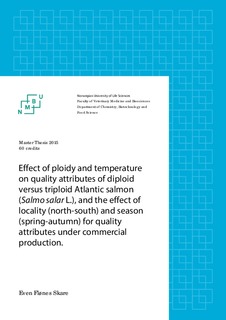| dc.description.abstract | Fillet quality of farmed Atlantic salmon (Salmo salar L.) is affected by a broad range of pre- and post-mortem factors. The “green A licenses” in North-Norway has led increased focus on triploidisation of Atlantic salmon (again) in the Norwegian aquaculture. Based on that, this thesis focused mainly on the effect of ploidy and temperature on quality of raw salmon fillets. In addition, the effect of locality (north-south) and season (spring-autumn) on quality during commercial production of diploid Atlantic salmon was studied. Both pre- and post mortem factors are investigated, and among post mortem factors temperature, drip loss, water holding capacity (WHC), fillet firmness, rigor development and chemical composition are important. To study the effect of locality (north-south) and season (spring-autumn) on fillet quality, salmon were divided into four groups. Salmon were sampled from the waiting cage or well boat by Marine Harvest facilitys at Hjelmeland and Herøy, both in May and November 2014 (average full weight 5.42 ± 0.99 kg). This resulted in a sample design with four groups based on locality (north-south) and season (spring-autumn). To study the effect of ploidy and temperature on fillet quality, salmon (average full weight 1.55 ± 0.34 kg) were picked from the Institute of Marine Research experimental indoor facilities (Matre). This resulted in a sample design with six groups based on their ploidy (diploid and triploid) and growth temperature (5, 10 and 15°C). In the first project, “The effect of locality (north-south) and season (spring-autumn) on quality”, it is concluded that locality (north-south) and season (spring-autumn) did affect the drip loss of commercial farmed diploid salmon. Moreover, it is concluded that locality (north-south) had a clear main effect on fillet firmness. In the second project, "Quality differences between diploid and triploid salmon”, it is concluded that triploid salmon has higher collagenase and fat content compared to diploids. Moreover, it is concluded that growth temperature affect rigor mortis, but the effects of ploidy is however not clear. The drip loss in triploid salmon were found to be nominally higher compared with diploids, and growth temperature were found to increase the drip loss from the fillets. The quality of triploid salmon seemed however to be remarkably similar to diploids when the fish had the same background. In accordance with the results in this thesis, the presented study demonstrate significant variation in biometrical traits and quality attributes between locality (north-south), season (spring-autumn), ploidy (diploid-triploid) and growth temperatures (5, 10 and 15°C). | nb_NO |
